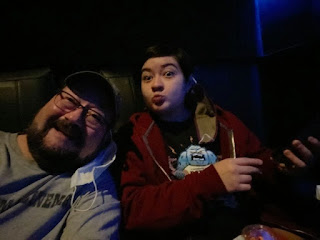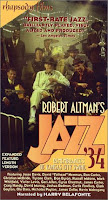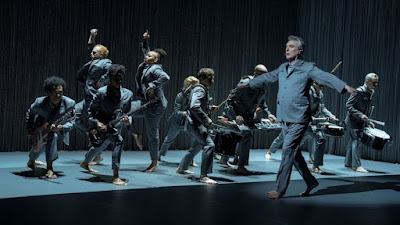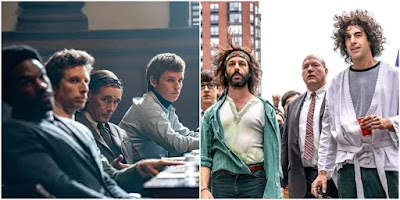FIVE FOR THE AGES: 2021 SO FAR
I haven’t seen much so far in 2021, and much of it has been either worthy, if flawed (Roadrunner: A Film About Anthony Bourdain) or flat-out incoherent and reprehensible (The Hitman’s Wife’s Bodyguard). But there have been five films released in 2021 so far which I have unequivocally loved.
1) As big leaps in visual storytelling go, David Lowery’s The
Green Knight marks a significant one for him, out of the clutches of
dead-end Malick homages (like 2013’s insufferable Ain't Them Bodies Saints
and 2017’s emotionally effective but sometimes too precious A Ghost Story)
and onto a masterful confidence that accesses a rare quality in modern movies—a
sense of genuine mystery.
Lowery’s film is an adaptation of the poem “Sir Gawain and the Green Knight”
(you probably read it in college; somehow, I did not and never have), in which
the nephew of King Arthur, young Gawain, played with almost sculpted perfection
and empathy, sans a trace of cloying, by Dev Patel, accepts a Christmas day
challenge from the titular arboreal nobleman to offer a blow in combat which
will then be reciprocated a year later. (The film’s first line, “Christ is born,” uttered
over the visage of a sleeping Gawain stunned out of a suggestive dream of chivalry
by a bucket of water, grounds the narrative’s engagement of an age of magic making
its transition toward another sort of mythology.) Gawain accepts the challenge
and impulsively offers the knight not a laceration but a beheading. But when the
knight’s decapitated body rises and rides off holding his own head, Gawain is
set upon his own quest, girded by the incorporeal guidance of his sorceress
mother Morgan Le Fay (Sarita Choudhury), who it seems has conjured the Green
Knight’s presence in the first place, to fulfill the demands of the game and
meet the knight a year later so that his own violent gesture can be returned in
kind.
Gawain’s journey to meet the Green Knight and his fate is, of course, episodic
in nature, the young would-be knight encountering thieves, ghost, giants, mysterious
noblemen and women, and even a talking fox, all with secret motivations of
their own, and along the way losing gifts given (like his mother’s protective
sash and the Green Knight’s enormous ax), only to be reunited with them in moments
that reinforce the film’s sly doubling motifs. But Lowery mounts the entire journey
with enchanting visual strategies that suggest the circularity of experience,
the inevitability of time (and its possible reversal), the weight of loss, and a
hallucinatory dream quality that suffuses Gawain’s pursuit of what it means to
be worthy of leading a honorable life—in its way, The Green Knight is
Lowery’s own Gawain-esque fulfillment of the promise of the themes of nature
and temporality that were improbably raised in his most commercial project to date,
2016’s lovely and entirely unexpected remake of Disney’s Pete’s Dragon.
The director carries a willing audience along on waves of visual grammar and
wit that are less related to the fevered Wagnerian blasts of John Boorman’s Excalbur
and closer to the contemplative pastoral inquiry of Robert Bresson’s Lancelot
du Lac, yet that grammar and wit are ultimately proven to be entirely his own.
And in a film about a young man’s shadowing of his own story, Lowery even
manages clever references to the process of narrative and filmmaking that for
once do not come off as if we were being held hostage by the overconfident
cackling of a director-raconteur seduced by his own mastery and incapable of not
showing it off, to the ultimate detriment of his own creation.
As with any surprising and original work, it’s best to go
into The Green Knight with only the sketchiest of expectations, although
by now the sort of praise it’s been gathering comes with its own set of
expectations apart of the actual action of the film. (After you’ve seen it, I
highly recommend Justin Chang’s excellent full-on appraisal in the Los
Angeles Times.) It’s a serious consideration of notions and quasi-historical narratives of chivalry and
honor that one would think impossibly quaint nearly 50 years after the sort of
pop culture disembowelment served up by Monty Python, and it conjures a world
of real and imagined magick, and that includes magick of the cinematic sort,
with both surprising guilelessness and a surety that can make a jaded audience
gasp. The marvelous cast, apart from Patel (making up for appearing in last
year’s worst film, The Personal History of David Copperfield, by
appearing in a candidate for this year’s best), includes Alicia Vikander,
doubly beguiling as Gawain’s tomboyish love, whom he leaves behind, and a mysterious
enchantress who may spell his doom, as well as seasoned character actors like
Sean Harris, Kate Dickie, Joel Edgerton, and best of all, Ralph Ineson, whose
great, quarry-deep voice perfectly inhabits the grandeur of the hulking, creaking,
rustling, forbidding, seductive figure of the film’s title, and who eloquently embodies
its most enrooted concepts of nature and inevitability.
And they are all led by a young director who is, with any luck, apparently just
now hitting his stride. Like its namesake, Lowery and The Green Knight invite
us on an unexpected journey we cannot but accept, one whose sweetest and most
profound rewards cannot be anticipated, one which will, if you’re like me,
resonate long after the film’s soaring penultimate image and its final, sweetly
ambiguous words have passed into the mists of memory, where the movie promises
to live from a forgotten age, of tales and of glorious movies, for a long, long
time.
2) At first I thought I might well find Carlos López
Estrada’s Summertime insufferable— it’s a celebratory
comedy-drama built around sequences in which many of the 30 young characters,
who float in and around Los Angeles during the film’s 95-minute running time,
frequently express themselves in poetic verse (poems the actors wrote
themselves). But the movie breaks down all resistance almost immediately with
visual poetry that augments and enhances those recitative passages and suffuses
them with what can only be considered the near-equivalent of song-and-dance
sequences which might be found in a more straightforward musical. That poetry
is put to powerful dramatic use as well, and by the movie’s end the tears Summertime
earns are a mixture of a piercing emotionality and the rapture of seeing
such material so well served, so eloquently expressed. In its very own, unique way it’s a lovely,
generational response to the sort of American expressionism that has itself
frequently been marginalized, fulfilling the promise of a more fantastical work
like In the Heights and adding to a legacy of social and political
portraiture that has its roots in masterworks like Nashville and Do
The Right Thing. (The movie shares an observational acuity toward LA with
those movies and their settings too.) And I guess I needn’t have worried that I
wouldn’t be transported by Summertime— how could I have ever not loved a
movie that has, as one of its threads, the pursuit of a real Los Angeles
cheeseburger, and locates the climax of that search in such a unifying, and
yes, inspirational gesture of community and empathy?
3) “We were creating a new world…” Summer of Soul
is that rare piece of work that, in its own way, seems almost as important as
the event it documents, especially given the past few summers we’ve had to
endure as a country, as a species. Joyous tears will likely never be too far
from spilling, as they were for me, witnessing the otherworldly, yet completely
of this world performances of Gladys Knight and the Pips, Sly and the Family
Stone, Abbey Lincoln, Nina Simone and especially Mavis Staples, on her own and
in rapturous duet with the great Mahalia Jackson. I love Mavis Staples, perhaps
beyond reason and propriety. But I was also just as thrilled that director Questlove,
in making beautiful music of both the concerts and the social context in which
they occurred, managed to make time to include Moms Mabley (who gets off a
great joke about the concurrent NASA moon mission which resonates today, as millionaires
indulge their own space fantasies while citizens continue to be marginalized
and murdered and while the planet burns), and for a moving interlude in which Marilyn
McCoo and Billy Davis Jr. are overwhelmed with emotion as they watch footage of
their performance at the 1969 Harlem Cultural Festival, which this documentary
commemorates (or should that be resuscitates?), and talk about their experience
as artists perceived as not having been “Black enough.” This movie is as close
to genuine cinematic bliss as I’ve experienced in years, and I’m so glad I got
to see it on the big screen. Whether or not you can swing a theatrical
experience, or whether Hulu is your gateway, this is a movie that should not be
missed.
5) I loved Godzilla vs. Kong. My
two daughters and I had a great time with it, even if it was only on HBO Max—
we turned it up loud, laughing and shouting and screaming in all the right
places. But then we saw it again, this time on the big screen before it left
our local multiplex. The damn thing must have taken a nation’s worth of
craftsmen and artists to compose, but it lumbers not— in light of the
four-hour Justice League especially, this is as fleet of foot
and spirit as you could hope for in a movie about giant beasts asserting their
essential (but not necessarily hostile-to-mankind) beastliness and laying waste
to their surroundings, including a surreally gorgeous nighttime Hong Kong
that’s neon-lit for maximum eye-popping monster fun. But the highlight for me
was the mind-and-perspective boggling landscape of Hollow Earth, revealed when
our human heroes travel beneath the surface to find out where the ancestors and
cohabitants of Kong and Godzilla have been calling home for centuries. It’s a
truly spectacular vision of a hidden world within our own that itself warrants
at least a couple more viewings to be even close to fully taken in. I know, I
know-- if you love cinema as an art form, you’re supposed to reflexively shun a
big, loud, commercial piece of work like Godzilla vs. Kong. But
screw that. The big boys (plus a surprise guest) were worth that second helping,
and now that I have the Blu-ray a third is surely forthcoming. Godzilla, Kong,
their surprise guest, and the disorienting grandeur of Hollow Earth await my return.
*****************
































































